Global Monitor (October 2006)
Consult the Guinness Book of World Records if you want to know which monster truck has made the highest jump ("Bigfoot 14"—24 feet) or the length of the longest freight train ever (a 4.5-mile string of 682 ore cars). But only POWER can "certify" claims for being the first, fastest, or biggest in the world of electric power. After vetting an unusual number of such claims received last month, we present for your consideration a short list of those that passed muster.
First live superconducting cable
The world’s first in-grid superconducting power cable was energized in Albany, N.Y., on July 20. The 1,150-foot-long underground cable—intended to demonstrate that high-temperature superconducting (HTS) wire can improve electricity transmission and distribution by integrating all three phases into a single cryostat—operates at 34,500 volts, with a nominal carrying capacity of 800 amperes (Figure 1). The cable was developed by SuperPower Inc. (www.superpower-inc.com), a subsidiary of Intermagnetics General Corp, and its partners Sumitomo Electric Industries Ltd. (www.sei.co.jp) and BOC Group, which merged with Linde Groupe (www.linde.com) this August. It links the Riverside and Menands substations of the North Albany Service Center of National Grid USA (www.nationalgridus.com) via a standard utility underground right-of-way (Figure 2).
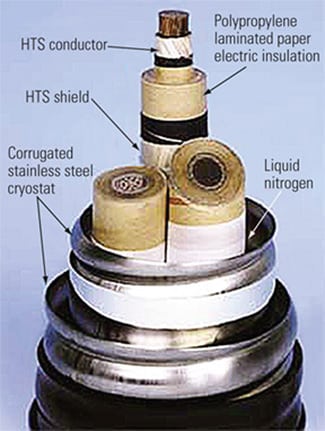
1. Super cable. This high-temperature superconducting (HTS) cable combines all three cores (one per phase) into a single, liquid nitrogen-cooled cryostat. The structure reduces cable diameter and heat invasion. Source: Sumitomo Electric Industries Ltd.

2. Out of sight. The superconducting cable links two National Grid substations in Albany, N.Y. Source: SuperPower Inc.
The cable now in use in Albany uses first-generation HTS wire, but about a year from now a portion of it will be replaced by second-generation conductor to demonstrate the successor’s viability. According to SuperPower, the "2G" HTS wire (which can handle more than 100 times as much current as a conventional copper wire) should be less costly to manufacture than its predecessor, so it should become commercially viable sooner. The key to the cable’s efficiency is the use of liquid nitrogen to cool it to minus 328F, about 70 degrees above absolute zero (Figure 3).
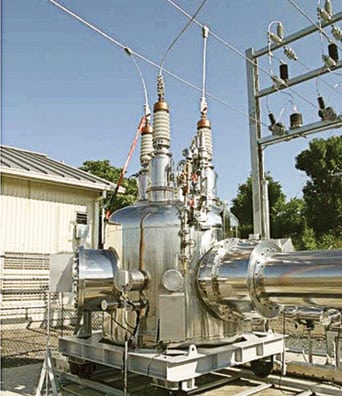
3. The terminator. Cable terminations to the existing grid are made through a stainless steel cryogenic vessel. The building behind it houses the refrigeration system and a back-up tank of liquid nitrogen. Courtesy: SuperPower Inc.
"Use of HTS cables has the potential for enormous impact on consumers and the utility industry," said Philip J. Pellegrino, president of SuperPower. "Congestion on electricity highways has become a major problem. HTS technology enables transmission and distribution of power through cables that are much smaller than comparably rated conventional copper conduits—a big plus in space-constrained urban areas."
The first-generation cable that was energized this July uses HTS wire made of compounds of bismuth, strontium, calcium, copper, and oxygen; it will be operated for about a year. Simultaneously, the developers will set the stage for installation of a 100-foot section of cable containing more than 6 miles of the second-generation wire, built from compounds of yttrium, barium, and copper oxide. Subsequent testing will seek to verify that the inserted 2G segment improves overall cable performance.
The $27 million cost of the program is being shared by the project partners ($7.5 million), the New York State Energy Research & Development Authority ($6 million) and the U.S. Department of Energy ($13.5 million). Although this isn’t the first time the DOE has underwritten half the cost of such an important project, the department deserves kudos for spending taxpayer dollars wisely on this one.
Biggest CO2 storage project
Another record claim came from Shell and Statoil, which have agreed to study the feasibility of developing what would be the world’s largest project to store CO2 and use it for enhanced oil recovery (EOR) from underground fields.
CO2 flooding is a proven EOR technique (Figure 4). Injections of the gas deep into a reservoir reduce the viscosity of trapped oil, facilitating its flow to rigs on the surface and recovery of additional barrels from mature fields. To reduce environmental impact, the CO2 that returns with the oil is recycled and reinjected. Once a field has been depleted, it can permanently sequester CO2 underground.
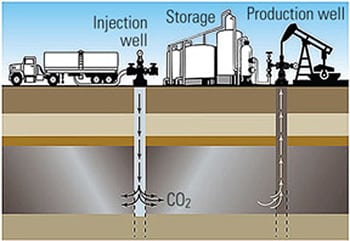
4. Bane becomes boon. CO2 injection can extend the life of a mature oil field. Any CO2 that resurfaces with hydrocarbons is recycled and reused. Source: Lawrence Livermore National Laboratory
The CO2 storage project is part of a plan to build an 860-MW natural gas-fired power station and methanol production plant at Tjeldbergodden on the Norwegian coast of the North Sea (Figure 5). The power station would be fueled by natural gas from offshore wells, and some of the CO2 the facility generates would be piped out to enhance recovery from the Shell-operated Draugen field and the Statoil-operated Heidrun field (Figure 6). Production at each field peaked in the late 1990s, and both now inject water to maintain pressure.
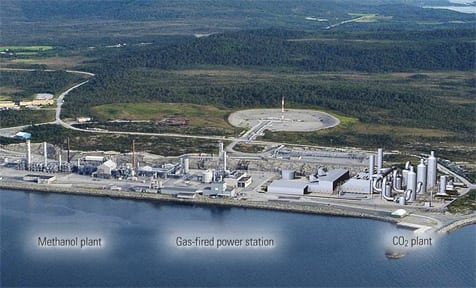
5. Triple play. Artist’s conception of the three parts of the proposed Tjeldbergodden facility. Source: Statoil
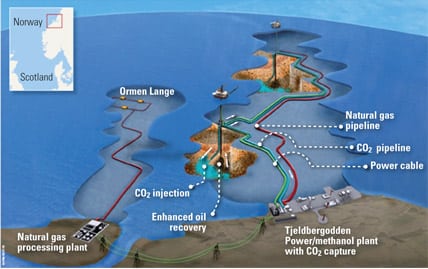
6. Perfect circle. CO2 captured from the natural gas-fueled Tjeldbergodden facility will be piped offshore to enhance recovery of oil and gas from two mature North Sea fields. Some electricity production also will be sent there, to power operations. Source: Statoil
The project schedule calls for completion of the feasibility study by the end of this year, selection of technology elements by the end of 2007, and a go/no-go investment decision by the end of 2008. If the project is deemed commercially viable, the power and methanol plants would be built by 2010-2011 and the first CO2 would be sent offshore a year later. Statoil and Shell think that the Draugen and Heidrun fields are capable of storing 2 to 2.5 million tons of CO2 annually.
Interest in carbon capture (see article) and sequestration (CCS) is already high in Europe and is beginning to spill over into the U.S. (to see how the DOE envisions sequestration, visit www.fossil.energy.gov/programs/sequestration/publications/programplans/2006/2006_sequestration_roadmap.pdf). In fact, the next generation of zero-emissions coal plants, such as FutureGen, will be possible only if CCS technologies can be commercialized. Economically, the Tjeldbergodden project has two things going for it: EOR will partially offset the cost of capturing CO2 from the facility, and any CO2 not used for EOR can be sequestered nearby, eliminating transportation costs.
Largest hydrogen-fueled plants
A similarly ground-breaking power project with carbon capture and sequestration (CCS) is being considered by BP (www.bp.com) on the Scottish coast of the North Sea. But this project’s power station would be fueled only by the hydrogen in natural gas, eliminating 90% of the CO2 emissions produced when the gas itself is burned. In a July announcement, BP said that it has agreed to collaborate with GE Infrastructure on the development of CCS technologies optimized for utility-scale hydrogen-fueled power generation.
BP revealed that it is now actively studying the feasibility of two hydrogen-fueled projects with CCS—the one in Scotland and another in California—both of which would use GE technology. If regulators approve and due diligence pans out, another 10 to 15 similar projects could be developed over the next decade.
The Scottish power station—rated at 350 MW to 475 MW and firing natural gas—would be located at Peterhead and built by BP and Scottish and Southern Energy (www.scottish-southern.co.uk). An integrated hydrogen plant (the first of its kind at industrial scale) would capture 1.2 million tons of CO2 a year. The CO2 then would be piped 150 miles offshore to the Miller field and used for EOR. Doing so could extend the life of the field by 15 to 20 years and enable recovery of an additional 40 million barrels of oil. The project, which would cost about $600 million, could be completed by 2010 if front-end engineering and design studies to be completed by the end of this year justify further investment.
The California power plant with CCS would be built in the city of Carson by BP and Edison Mission Energy (www.edison.com), parent of the local utility. Rated at 500 MW, it would extract its hydrogen fuel on-site from petroleum coke, capturing more than 3 million tons per year of CO2 in the process. This project could be completed as soon as 2011.
Occidental Petroleum Corp. (www.oxy.com) is currently discussing with BP options for sequestering CO2 from the proposed Carson plant in Oxy Pete’s mature California oil fields. The company is already the world’s largest CO2 operator; its injections of more than 1 billion cubic feet of CO2 per day into Permian Basin reservoirs in West Texas and New Mexico yield about 85,000 barrels of oil daily that otherwise would be unrecoverable. Technical studies are under way to determine which of Occidental’s California oil fields would most benefit from CO2 flooding.
Record run for fuel cell cogen system
A combined heat and power (CHP) system based on a solid oxide fuel cell (SOFC) from Siemens Power Generation (www.powergeneration.siemens.com) marked one year of near-perfect service this June. Installed at the facilities of the Siemens services subsidiary Gas Turbine Technologies SpA (GTT) in Torino, Italy, the system (Figure 7) generated 1,005 MWh over a 9,000-hour period and was available 99.5% of the time.
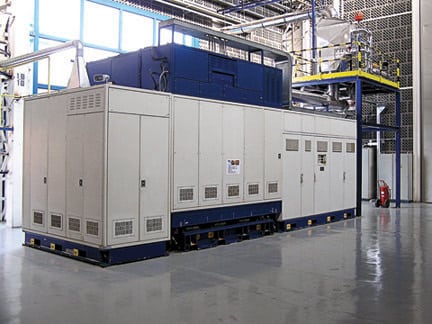
7. Happy birthday. A combined heat and power system based on solid oxide fuel cells from Siemens Power Generation operated continuously for a 9,000-hour period spanning one year at Gas Turbine Technologies in Torino, Italy. Courtesy: Siemens Power Generation
Equally impressive were the reported efficiencies of the CHP system (70% to 80%) and its tiny model SFC100 prime movers (up to 46%). Numbers like those have made fuel cell cogeneration systems strong competitors of gas turbines and reciprocating engines for jobs where cleanliness, compactness, and reliability are paramount.
Over the past year, GTT technicians noted that the system (rated at 110 kWe and 60 kWt) seemed immune to upsets from variations in the composition of the pipeline natural gas it uses for fuel. Even better, O&M has proved pretty much automatic. The most frequent maintenance procedures—replacing air filters and the reactant that removes sulfur from the natural gas—can be performed without taking the system off-line.
SOFC CHP systems very similar to the one in Italy previously were operated in the Netherlands (by Nuon and the Dutch/Danish Utility Consortium) from 1996 to 2000 and in Germany (by RWE) from 2001 to 2002. With the addition of the 9,000 hours from the Italian installation, the system now can boast of having run for 29,000 hours—a record for a SOFC system that is grid-connected and operating in CHP mode.
Other than Siemens, which developed the SOFC technology in cooperation with the U.S. Department of Energy, participants in the Italian project include Regione Government Piemonte, Politecnico di Torino, and the Environment Park of Torino. Currently, the fuel cell system supplies 20% of the electricity demand of GTT’s manufacturing facility and part of the thermal energy required for heating and air conditioning of GTT offices. During nights and weekends, the unit exports power to the municipal grid. This kind of cogeneration plant is best suited for distributed generation for industrial plants, malls, hospitals, universities, and mini-grid applications.
It is anticipated that in early 2008, a second Siemens industrial SOFC generator—the SFC200A, with new tubular cell materials and a new generator module design—will be installed at the GTT facility. Now being designed by Siemens Power Generation, it is expected to enable the CHP system to generate enough power to meet about 50% of GTT’s electrical demand.
Largest PV plant still in Bavaria
One of our Top Plants (POWER, July/August, p. 36) for 2006 was the 10-MW Bavaria Solar Park, christened in June 2005. Although there’s now a new "world’s largest photovoltaic power plant," the championship belt could be delivered by messenger. The new champ is Solon’s 12-MW Gut Erlasee Solar Park (also in Bavaria, near Arnstein, Germany), which entered commercial service on September 1 (Figure 8).
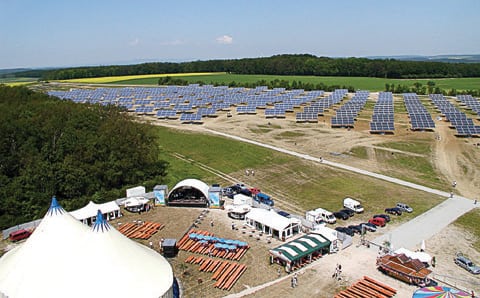
8. Burning sunshine. Bavaria’s 12-MW Gut Erlasee Solar Park became the world’s largest photovoltaic power plant when it began commercial service on September 1. Courtesy: SunPower Corp.
The U.S. remains a strong contender among PV cell vendors. San Jose–based SunPower Corp. (www.sunpowercorp.com) supplied the high-efficiency model A-300 solar cells that Solon (www.solon-pv.com) uses in its "mover" system for multimegawatt solar power plants. The "movers" automatically tilt and rotate the array during the day so it is always perpendicular to the sun, to maximize electricity production. At Gut Erlasee, SunPower’s solar cells power about one-third of the movers but generate a higher proportion of the park’s production due to their exceptional performance.
Luz returns to U.S.
Pacific Gas and Electric Co. (PG&E) has agreed to purchase at least 500 MW of solar energy capacity beginning in the spring of 2010 from Luz II, LLC. The solar thermal–generated power would be produced by a series of projects incorporating Luz II’s proprietary DPT 550, a hybrid solar-gas technology that meets a key requirement of the California Renewables Portfolio Standard Program (thermal input less than 25% natural gas). The technology also has the potential to dispatch electricity at any time of the day. The site for the plants has not been determined.
Solar thermal facilities use mirrors of various shapes to concentrate sunlight on a receptor. In the early 1980s, Luz I pioneered a parabolic trough-shaped mirror to aim sunlight on a receptor rod in the middle. The nine Luz I plants built in the 1980s with this design are still producing 354 MW in California’s Mojave Desert (Figure 9). At one time, Luz plants were producing most of the solar thermal electricity in the world; the company went bankrupt in the early 1990s. Luz II is led by its original management team, including former CEO Arnold Goldman. The company was bought out in the early 1990s by the Israeli firm Solel, which still uses the trough model. Luz II is based in Jerusalem and Towson, Md.
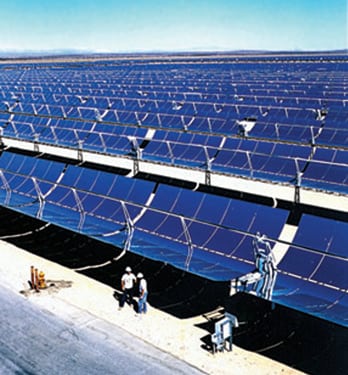
9. Back in business. Luz II developers are building on the many years of experience gained by the nine Luz I plants built in the 1980s. Courtesy: National Renewable Energy Laboratory
Luz II’s innovative distributed power tower (DPT) technology, based on 100-MW modules, is not only much more efficient at converting sunlight into electricity than the solar trough design used by the original Luz firm, it also is significantly less expensive to build and operate. Arnold Goldman, chairman of Luz II, said, "With DPT technology, the dream of cost-effective solar power is finally going to become a reality."
Luz II’s solar thermal tower stands between 200 and 262 feet high and sports an array of flat mirrors fanned out in front of it like an audience. It reaches temperatures of 1,022F, whereas trough technology generally tops out around 752F. The area needed for mirrors around the tower depends on how much sun is available at the site. Usually, the DPT 550 needs about 125 acres of mirrors to produce 100 MW.
There must be a new record in there somewhere.
POWER Digest
News items of interest to power industry professionals.
Coal mine methane powers engines. In the less-than-crowded category of plants fueled by coal mine methane, engine manufacturer Caterpillar Inc. (www.cat.com) scores a "world’s largest" mention for its $58 million deal with China to supply the equipment for a 120-MW power plant fired by the waste gas. The project is the result of collaborative efforts between the public and private sectors through the Methane to Markets Partnership, a U.S.-led initiative that now includes 17 countries, including China.
The power plant will use coalbed and coal mine methane recovered from the Sihe mine, and the heat of the Cat engines’ exhaust will be recovered to produce hot water and steam for the mining operations. Once the project has been completed, the release of an estimated 4.5 million tons of CO2 equivalent emissions will be avoided each year.
This project not only supports the goals of the Methane to Markets Partnership but also those of the Asia-Pacific Partnership on Clean Development and Climate, of which China and the U.S. are members. The Asia-Pacific Partnership, which debuted earlier this year, promotes energy security, cuts in air pollution, and reduction of greenhouse gas emissions worldwide.
The Methane to Markets Partnership was launched in November 2004 to advance cost-effective, near-term methane recovery and to use the greenhouse gas as a source of clean energy. For more information about the Methane to Markets Partnership, visit www.epa.gov/methanetomarkets.
EPA targeting stationary diesels. Ready to put selective catalytic reduction systems or scrubbers on your plant’s diesel engines? That could be the only way to comply with a new U.S. EPA mandate to reduce air pollution from stationary diesel engines by up to 90%. The new caps will be implemented in three phases beginning next year. By the time the new rules are fully implemented in 2015, the EPA estimates that 81,500 new stationary diesel engines will have to find a way to reduce their emissions of air pollutants by more than 68,000 tons each year. The standards also limit the amount of sulfur in the diesel fuel used to run the engines.
The upcoming New Source Performance Standards will limit emissions of nitrogen oxides, particulate matter, sulfur dioxide, carbon monoxide, and hydrocarbons from new or reconstructed stationary diesel engines to the same stringent levels required by EPA’s non-road diesel engine regulations. For more information on this action, visit: www.epa.gov/ttn/oarpg/t3/fact_sheets/ci_nsps_fnl_fs.html.
Wind projects still hot. MHI (www.mhi.co.jp) has received a bulk order for 443 of its 1-MW wind turbines from Babcock & Brown (www.babcockbrown.com), one of America’s biggest developers and owners of wind power. The turbines are slated to be used on four projects rated at several hundred megawatts each. The order is the largest MHI has ever received, and it brings the company’s aggregated wind turbine orders to date to 2,626 units (1,843 MW).
The order was placed through Mitsubishi Power Systems (MPS), a U.S. subsidiary of MHI based in Orlando, Fla. (www.mpshq.com). The destinations, counts, and schedules of the turbine shipments are as follows:
- The Buena Vista project in northern California: 38 units, to be operational by the end of 2006.
- The Argonne Mesa project in New Mexico: 90 units, to come on-line by the end of this year.
- The Sweetwater Units 4 and 5 expansion project in Texas:135 units, to be commissioned by the fall of 2007.
- An unidentified wind project in Colorado:180 units, for delivery by the end of 2007.
On a related note, AES Corp. has announced that it has begun construction of a 233-MW wind farm near Abilene, Texas, and signed a 10-year deal to sell all of its production at fixed prices to Texas retail electricity provider Direct Energy. The project, called Buffalo Gap 2, is an expansion of AES’s 121-MW Buffalo Gap wind farm, which commenced operation earlier this year. Once completed, the two projects will constitute one of the largest operating wind farms in the U.S.
AES has been in the wind generation business since 2004 and currently operates 600 MW of wind capacity. It recently raised its profile in Europe by acquiring a majority stake in Wind Energy Ltd. (WEL), a UK-based wind project developer. WEL now has 640 MW of wind farms in various stages of development throughout Scotland. Earlier this year, AES announced plans to triple its investment in wind generation over the next three years, and the company has an additional 2,000 MW of wind projects in development in the U.S.
AES purchased 155 General Electric 1.5-MW wind turbine generators for the Buffalo Gap 2 project, whose engineering, procurement, and construction contractor is D.H. Blattner & Sons Inc. Commercial operation is expected in mid-2007.
Super(critical) second choice. American Electric Power’s (AEP) Southwestern Electric Power Co. (SWEPCO) subsidiary recently announced its intention to spend about $1.3 billion to develop a 600-MW ultra-supercritical (USC) plant designed to burn Powder River Basin (PRB) coal on a 2,800-acre plot 15 miles northeast of Texarkana, Ark., by 2011.
In its announcement, AEP noted that it remains a strong supporter of IGCC (integrated [coal] gasification combined cycle) technology, as demonstrated by plans to build plants of that type in two eastern states. However, GE Energy would not offer SWEPCO the same performance guarantees for PRB coal as it offers prospective users of Eastern coals, so the company will have to "make do" with an advanced USC design. SWEPCO says it expects its fuel mix to remain at 85% solid fuel and 15% natural gas once all three plants are completed. This appears to be the first USC project to fire PRB coal announced in the U.S.
AEP taps GE/Bechtel again. GE Energy and Bechtel Power will design and build the second IGCC project that American Electric Power is proposing, a 630-MW facility to be sited in Mason County, W.Va. Appalachian Power, another AEP subsidiary, would operate the plant, which would be located next to Appalachian’s existing Mountaineer power plant. The same team began work on an IGCC project in Meigs County, Ohio, in September 2005. Procurement and construction on both plants could start after certain regulatory milestones are achieved.
If awarded the contract for the next phase of the West Virginia project, GE would supply the IGCC technology for the new plant while Bechtel would handle engineering, procurement, and construction. GE and Bechtel offer an IGCC Reference Plant—a standard commercial offering for projects in the U.S.—via a single point of contact.
Geothermal comes to Alaska. This July, United Technologies announced the startup of the 400-kW Chena Hot Springs geothermal power plant. "This project represents a major milestone in the utilization of low-temperature geothermal resources," commented Gwen Holdmann, vice president for new development of the Chena Hot Springs Resort. The plant should be able to satisfy all the power needs of the resort without relying on a grid connection.
Chena Hot Springs, just outside Fairbanks, is the first geothermal power plant to come on-line in the state. It is now also the site of the lowest temperature resource (165F hot water from a 700-foot deep well) ever used for commercial power generation in the world (our final world record of note this month), observed Bernie Karl, proprietor of the resort. Because the separate well supplying the cold water to be geothermally heated is at a higher elevation than the power plant, the working fluid can be gravity-fed, eliminating the need for a pump and its parasitic load.
For more information on the Chena Hot Springs geothermal project, visit www.yourownpower.com.